Disclaimer: This post contains affiliate links to handpicked partners, including tours, gear and booking sites. If you click through or buy something via one of them, I may receive a small commission. This is at no extra cost to you and allows this site to keep running.
All the reasons why you should visit Kampong Cham, Cambodia – a must-see city on the Mekong River, south of the capital, Phnom Penh.
You won’t find many travellers in Cambodia who have heard of Kampong Cham or have it on their list of places to visit. Yet, this must-see city on the Mekong River – the 12th largest in the country – is located only three hours from the capital, Phnom Penh, making it an ideal opportunity to explore one of the country’s rural provinces outside of its urbanised highlights.
You can only truly understand Cambodia’s complex and diverse makeup once you start exploring its lesser-known corners.
Our plans to travel to Kampong Cham were originally set out to be a quick stop there to break up the long journey we were taking from the southern coastal town of Kep to the eastern jungle lands of Mondulkiri (via a bus change in Phnom Penh).
When we arrived, the city felt so bizarre that my friend and I wondered if we had made the right choice to decamp here for a night or two. More like a subdued town, local life moved at a slow pace, backpacker hangouts and hotels appeared eerily quiet and empty, there were far fewer tuk-tuks and people traffic, and the easily navigable area from the riverfront to the other side of this urban pocket seemed to lack character. Since I had been living in Siem Reap at that time, I had grown to like the bustle of Cambodian cities, and this was very different.
But how wrong we were that nothing was happening in Kampong Cham city. The spontaneous visit was a welcome surprise, and there was plenty to see, do, and explore in the end. So much so that I advise you not to make this a fleeting day trip.
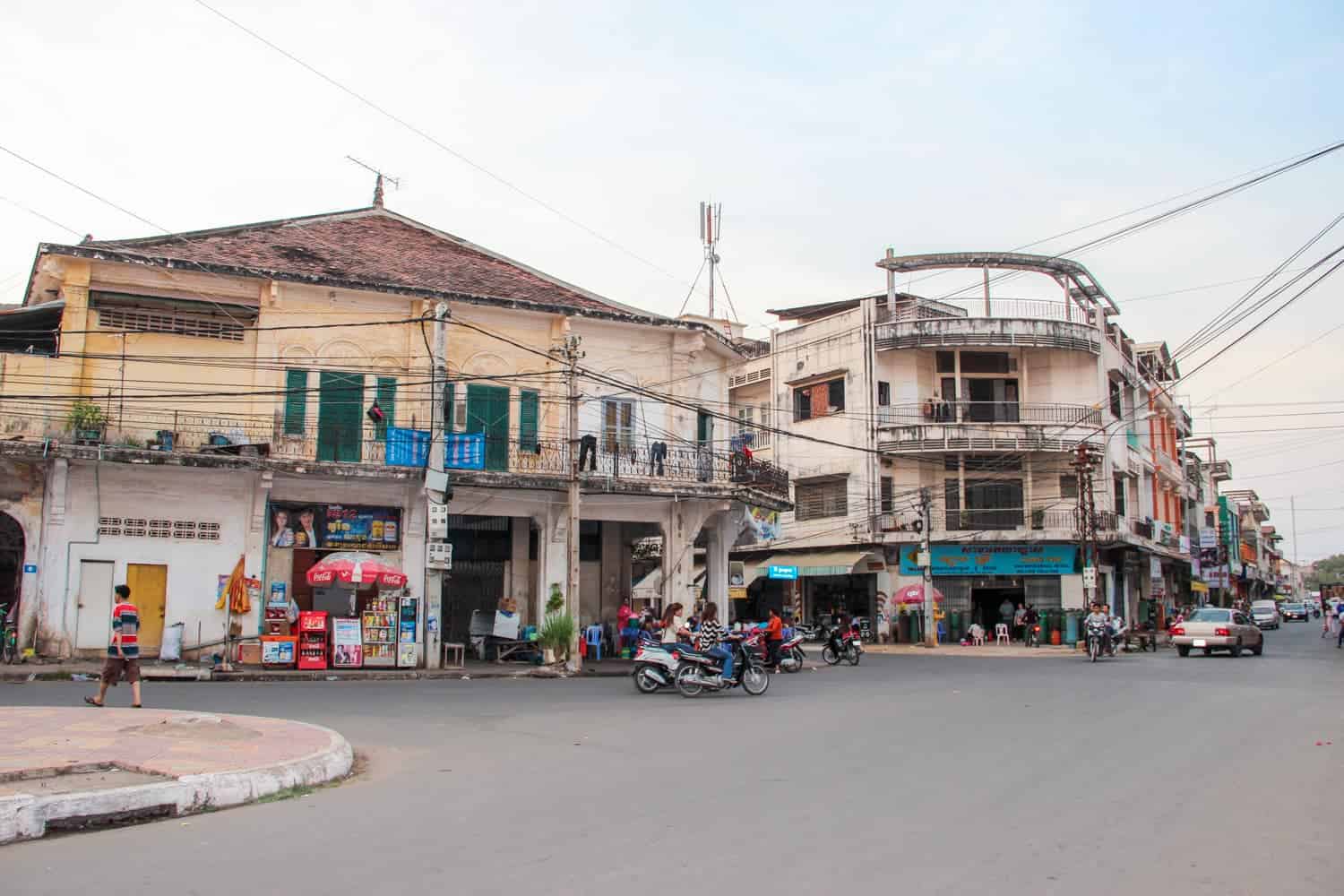
Why You Should Visit Kampong Cham – The Lesser-Known and Underrated City of Cambodia.
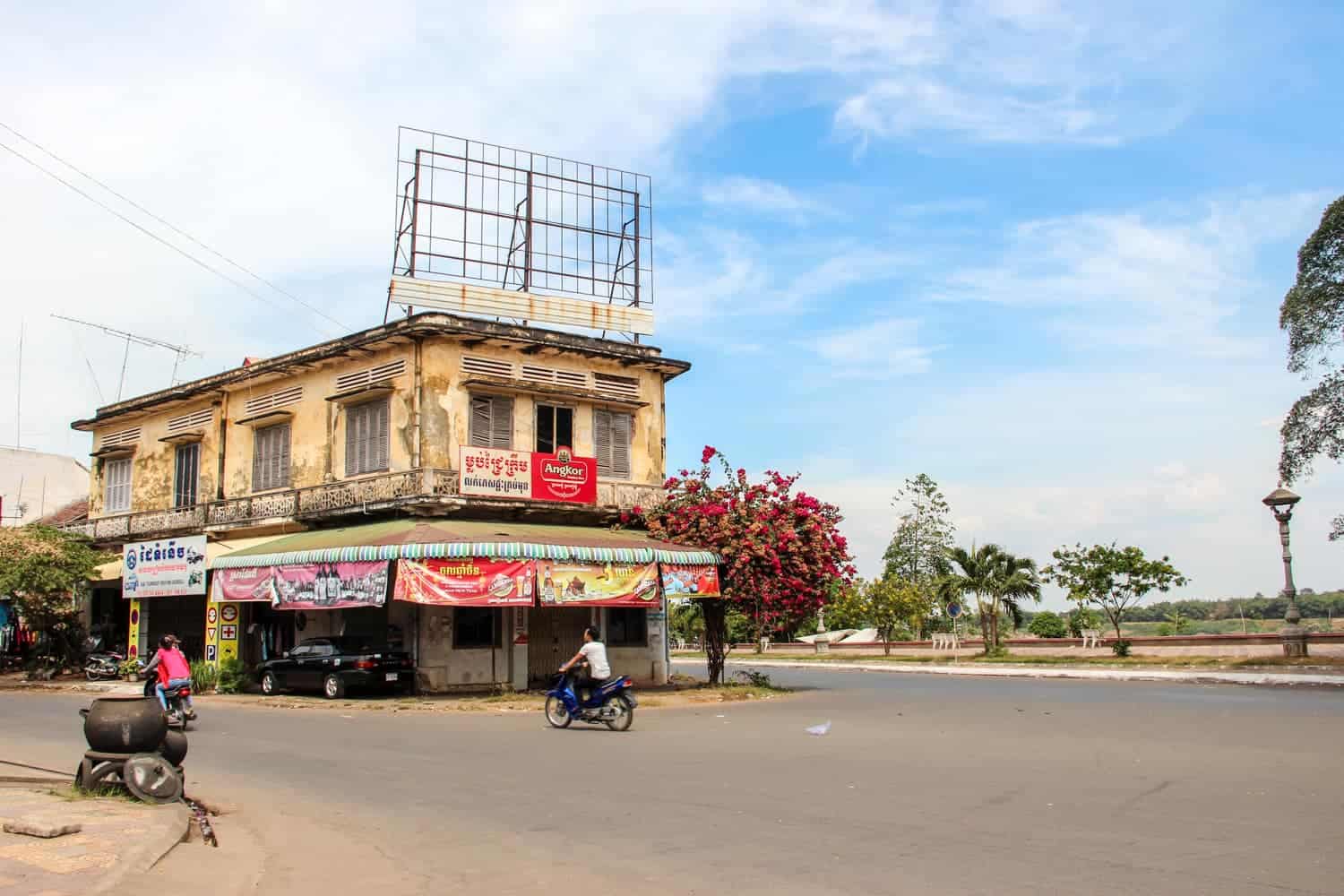
The quiet streets of Kampong Cham city.
Contents
Why You Should Go to Kampong Cham, Cambodia
You will likely be passing through the Cham rather than planning any particular long excursion there. I spent two days and one night in the city, and it fast became one of my favourite destinations in Cambodia.
It oozed charm; an underrated, hard-to-explain-unless-you-are-there-living-it charm that made it interesting. It wasn’t quaint, nor was it overwhelmingly pretty, yet the layers of the town’s former trading post status during the French era are still peeling. We were not hassled, and nor were we ignored. The emptiness and the calm of the place just had something about it.
The Koh Pen Bamboo Bridge
One of the main Kampong Cham attractions was the Koh Pen bamboo bridge that connected the mainland to a small lake island. I had always wondered why a Khmer friend from the town had once told me about it with such bounding enthusiasm.
This bridge was not only a feat of architecture – re-built every year when the river water subsides during the dry season and then taken down completely when the tide comes in – but an interesting contraption to cross with your bicycle.
I feel lucky to have witnessed it and to have made the journey across it because, sadly, the original and decades-old construction is no more. The last erected bamboo bridge construction was in 2016, where thereafter a government-funded steel and concrete bridge was built further up the river, meaning the iconic Kampong Cham bridge came to an end.
However, the owner of the old bamboo bridge told the Phnom Penh Post newspaper that since it was a tourist attraction, its loss also signalled a loss in income for the community. “To avoid this, last year enterprising locals decided to keep the tradition alive on a smaller scale by building a tourist-friendly, pedestrian-only bridge as a replacement,” states the article.
Either way, you will find some remnants of this old tradition when you are there.
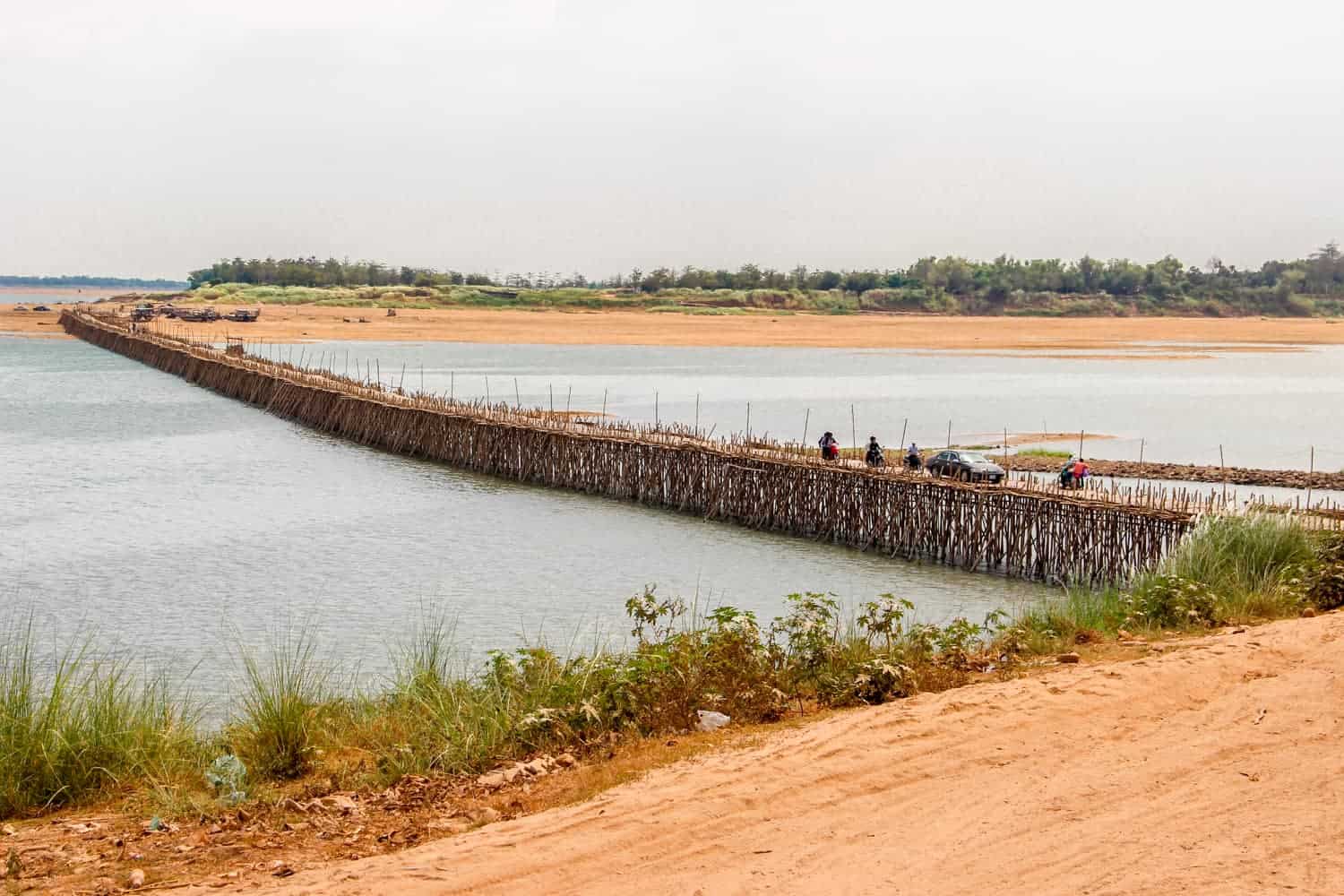
The famous Koh Pen Bamboo Bridge in Kampong Cham.
My friend and I screeched like children as we made our way over. The click and clatter of the bamboo strips and the softness of the multiple layers felt like they could give way any minute. You dared not look over the edge; motos and cars would zoom past you, creating an adrenalin-fuelled wobble in the path as you tried to find your momentum again.
It was unique and exhilarating, although be prepared to pay for the privilege – the dollar you pay being over four times that of the local price.
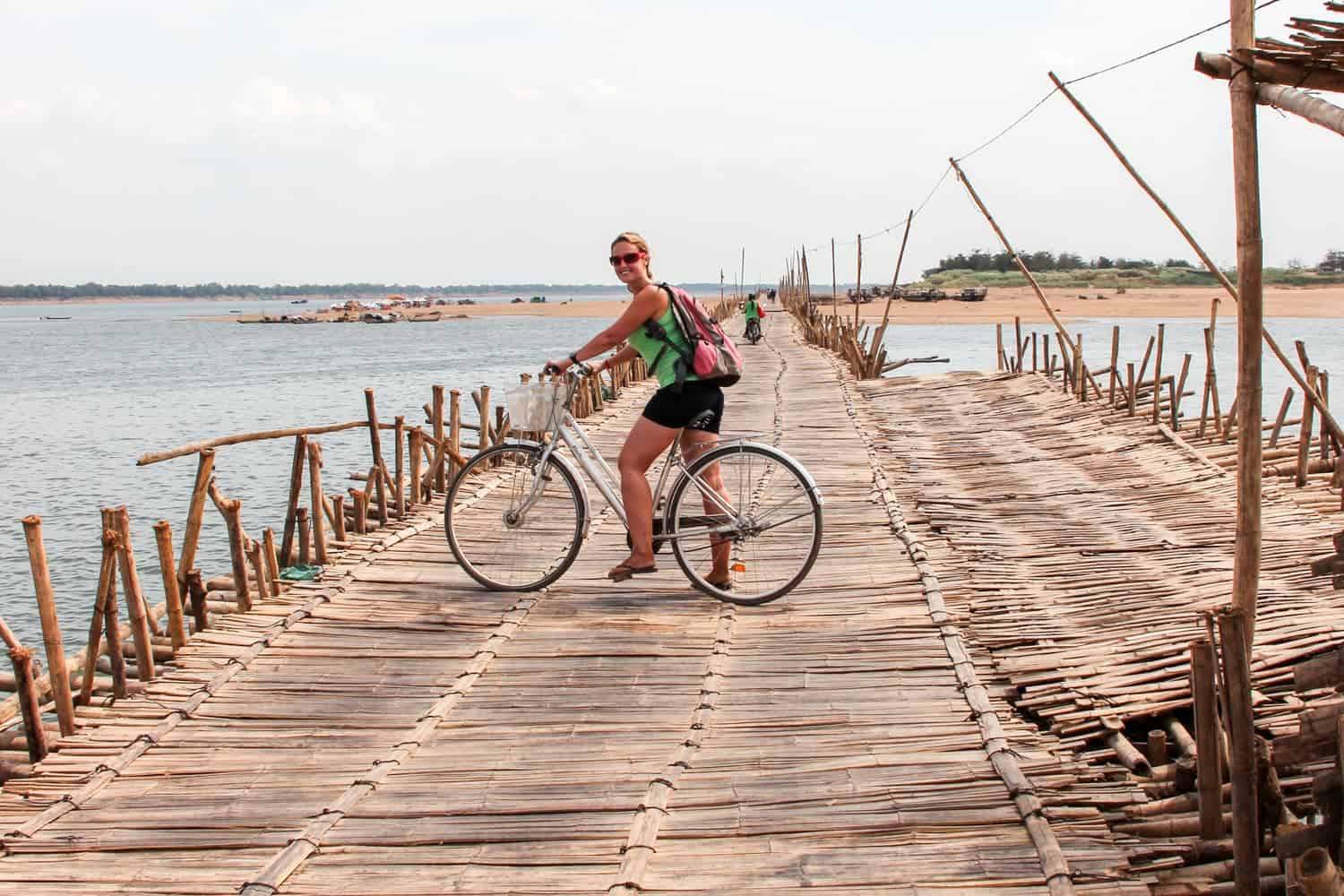
Crossing the bamboo bridge in Kampong Cham.
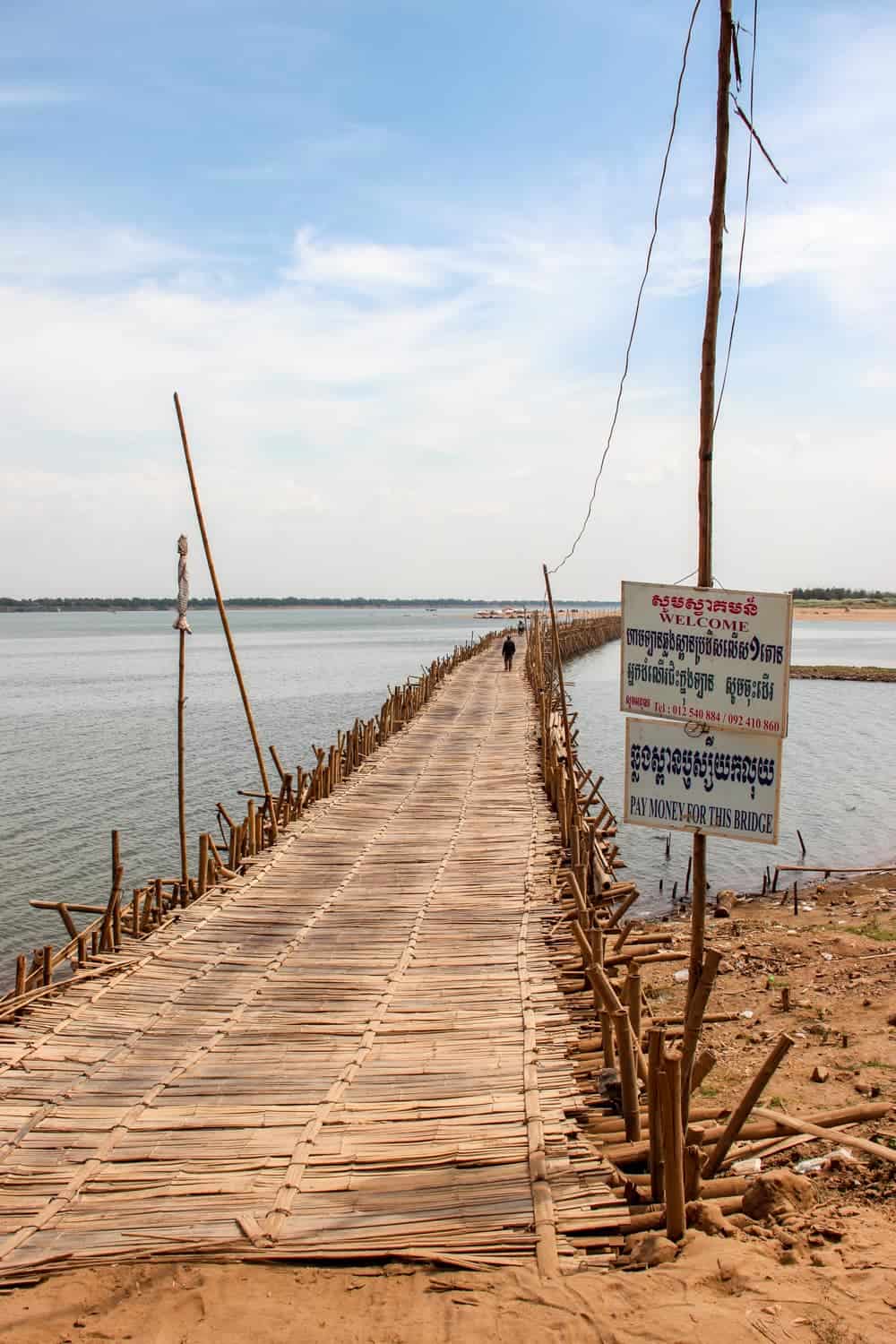
Whether by foot, motorbike or bicycle, you have to pay to use the bamboo bridge.
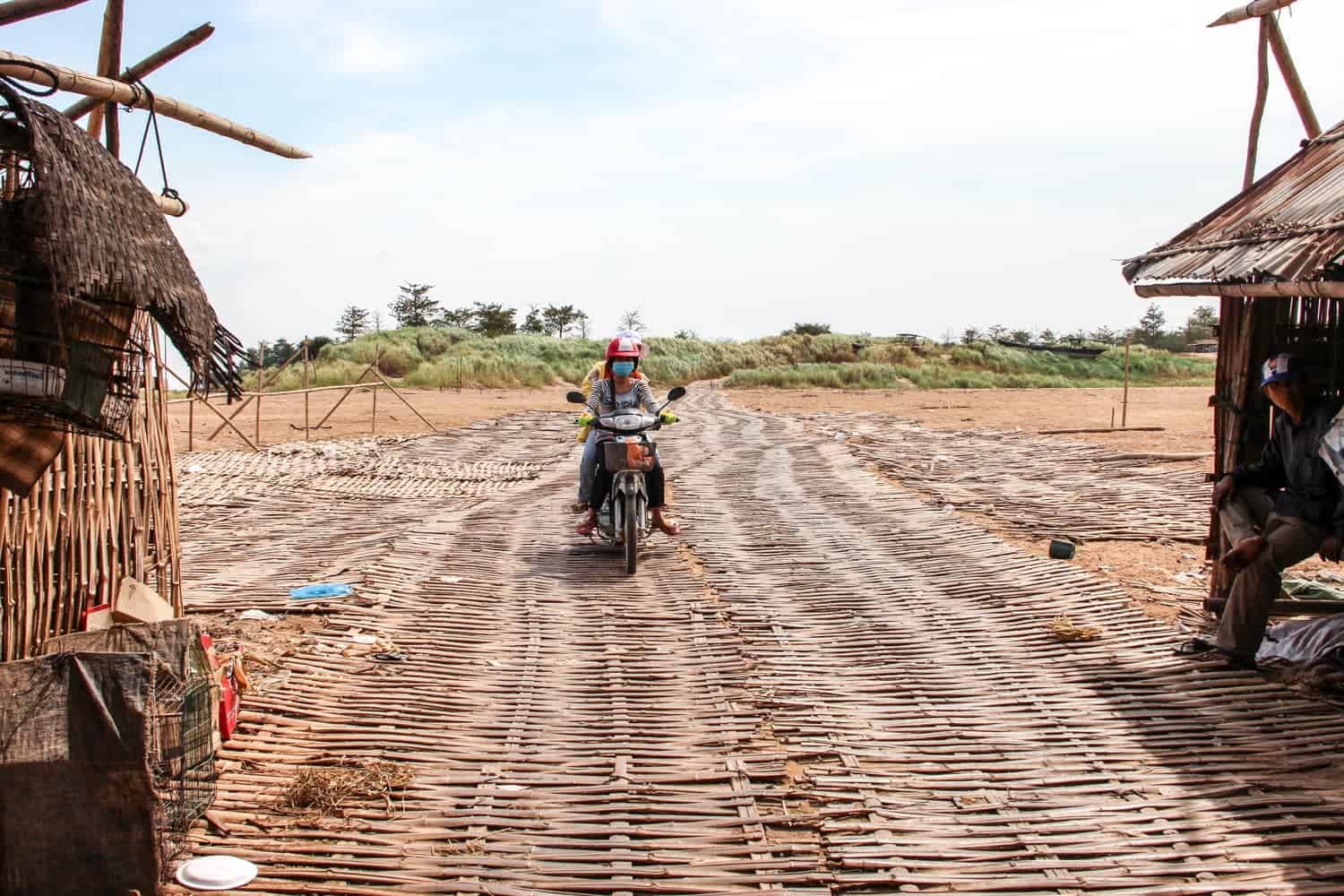
Crossing the bamboo bridge on motorbike.
Biking on Bamboo Bridge Island – Koh Paen
Koh Paen – the island you find yourself in after crossing the bamboo bridge – is a giant village. Our grand idea of cycling all the way around it was cut short when we realised that we had been cycling for over an hour and had not made much progress in reaching the halfway point on the island’s circumference. We still hold on to the belief that the road was never-ending.
Still, there is nothing else to do besides looking at people’s lovely houses and the farming landscape alongside random cows, corn cobs, and stinky durian fruits.
You can hire a bike in town for as little as $2 for the day.
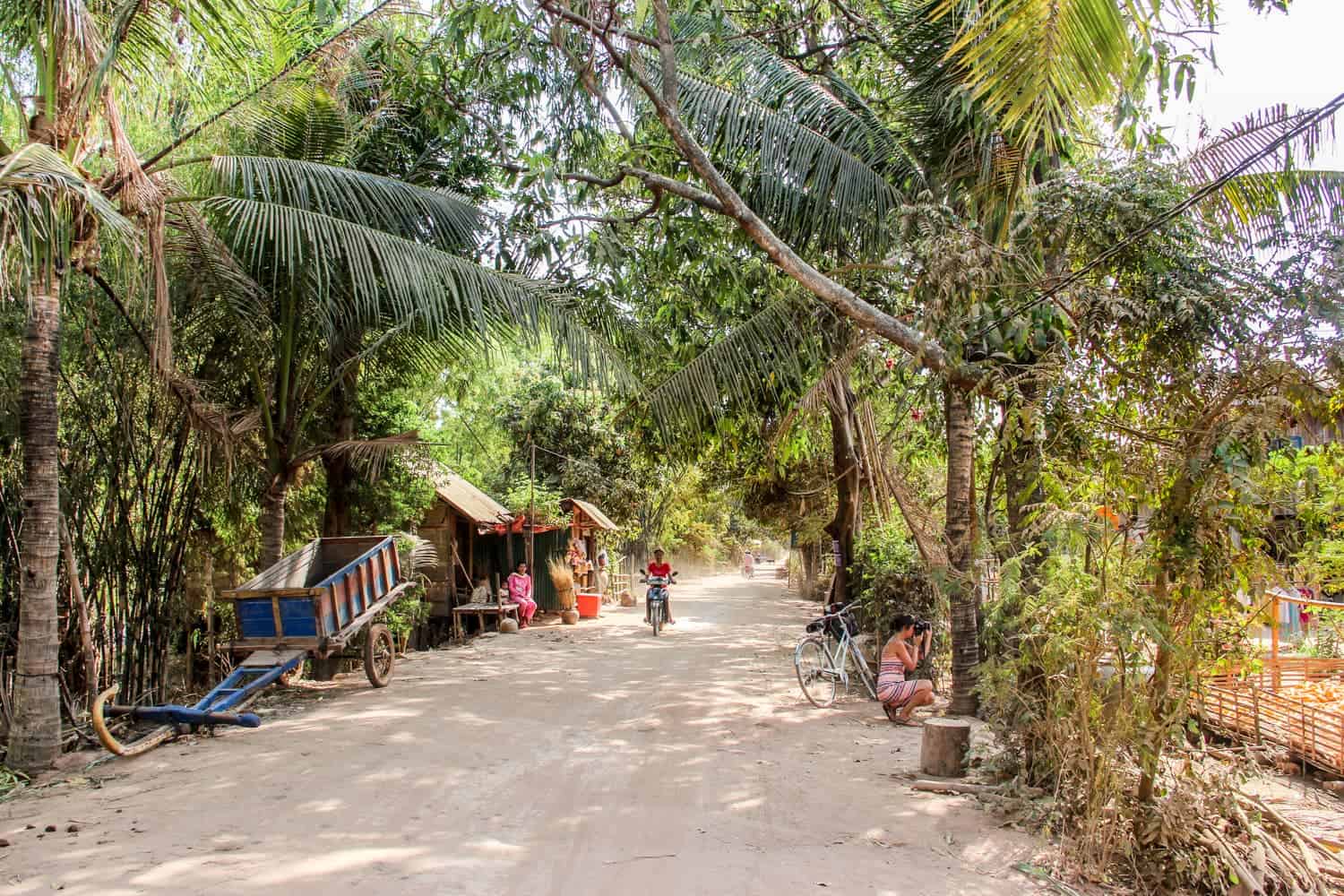
Visitng Kampong Chang’s island.
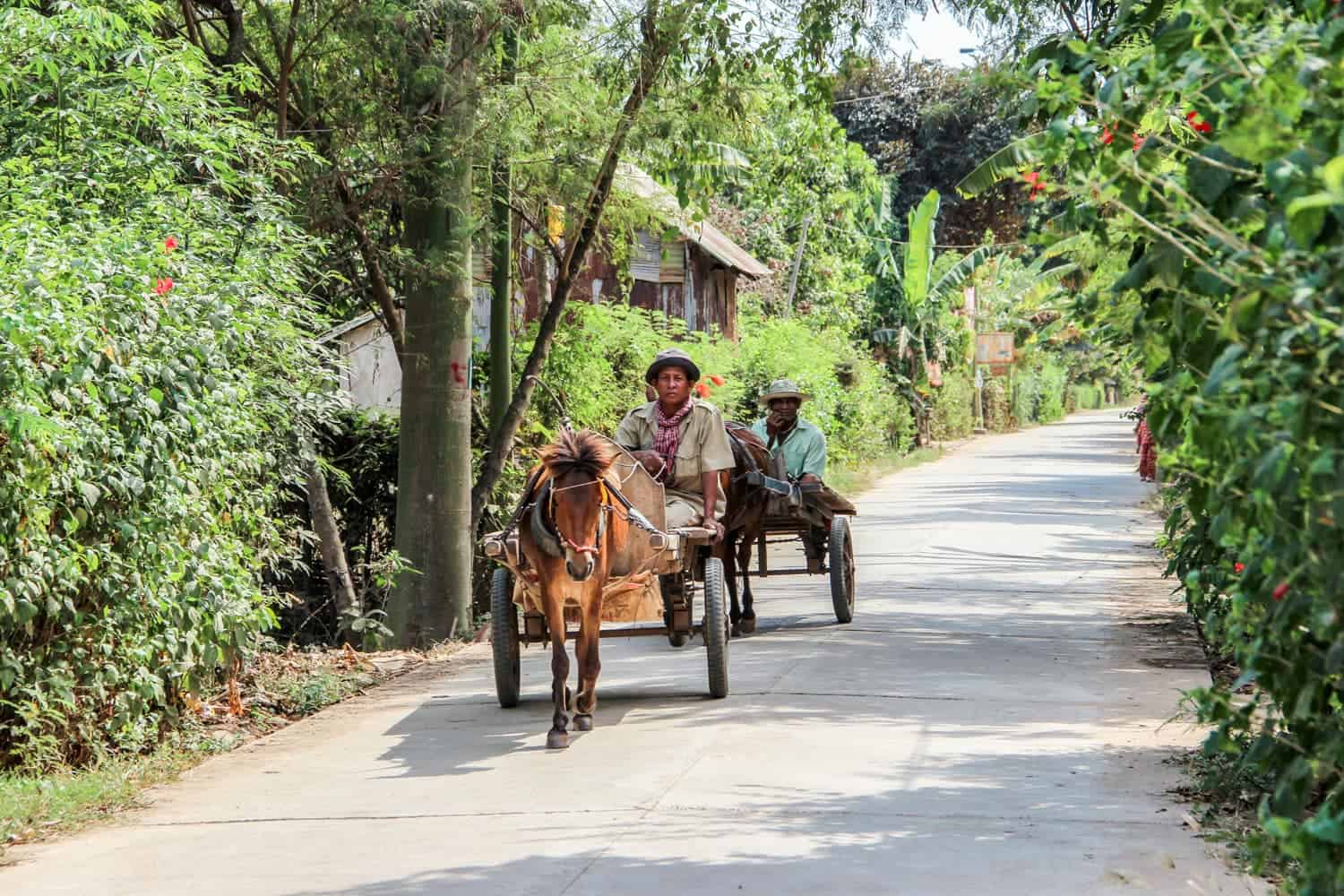
Life on the Island connected to the bamboo bridge crossing in Kampong Cham.
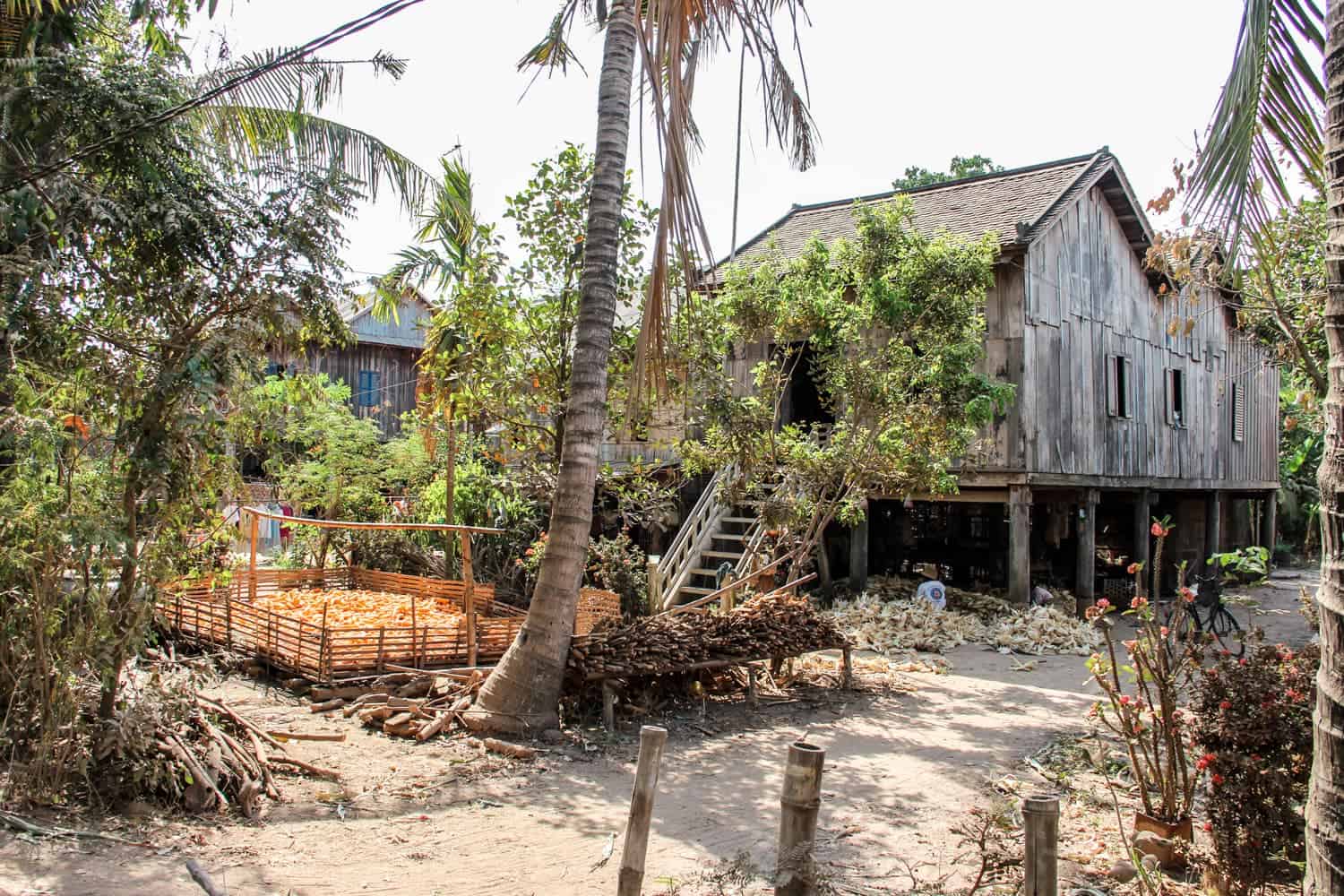
Traditional Cambodian wooden houses on the island off Kampong Cham.
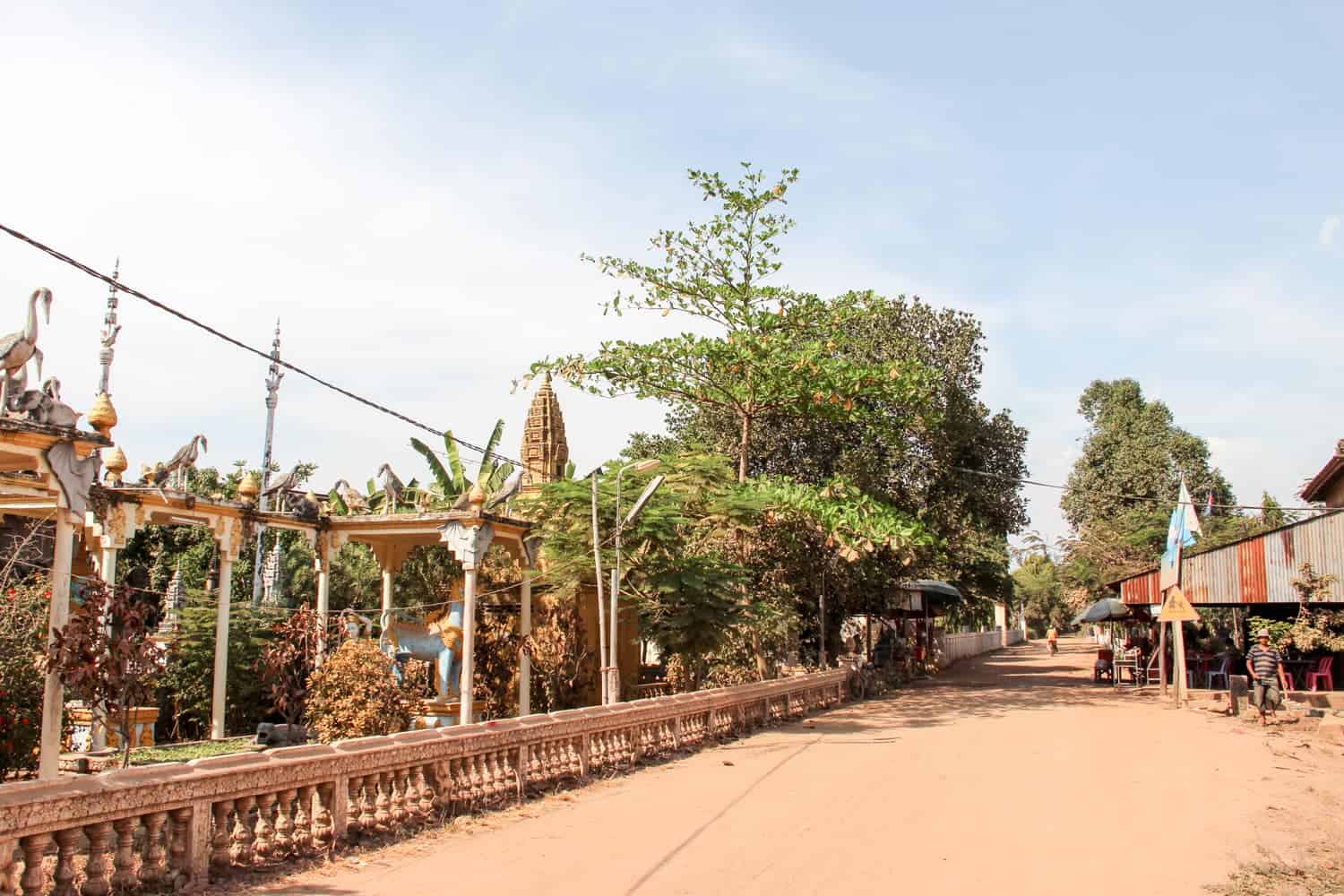
Temples on the Island.
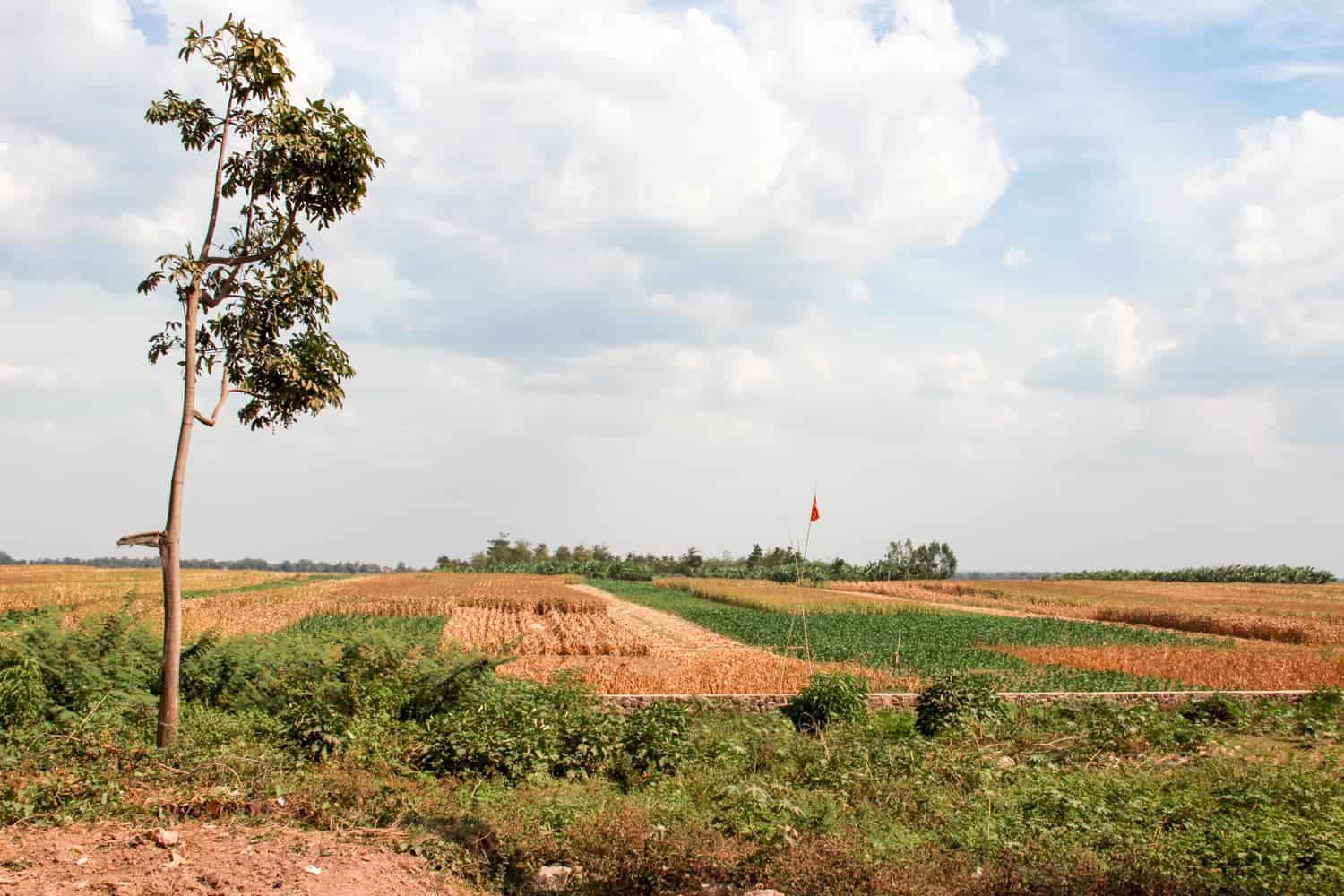
Island fields on the other side of the Bamboo Bridge.
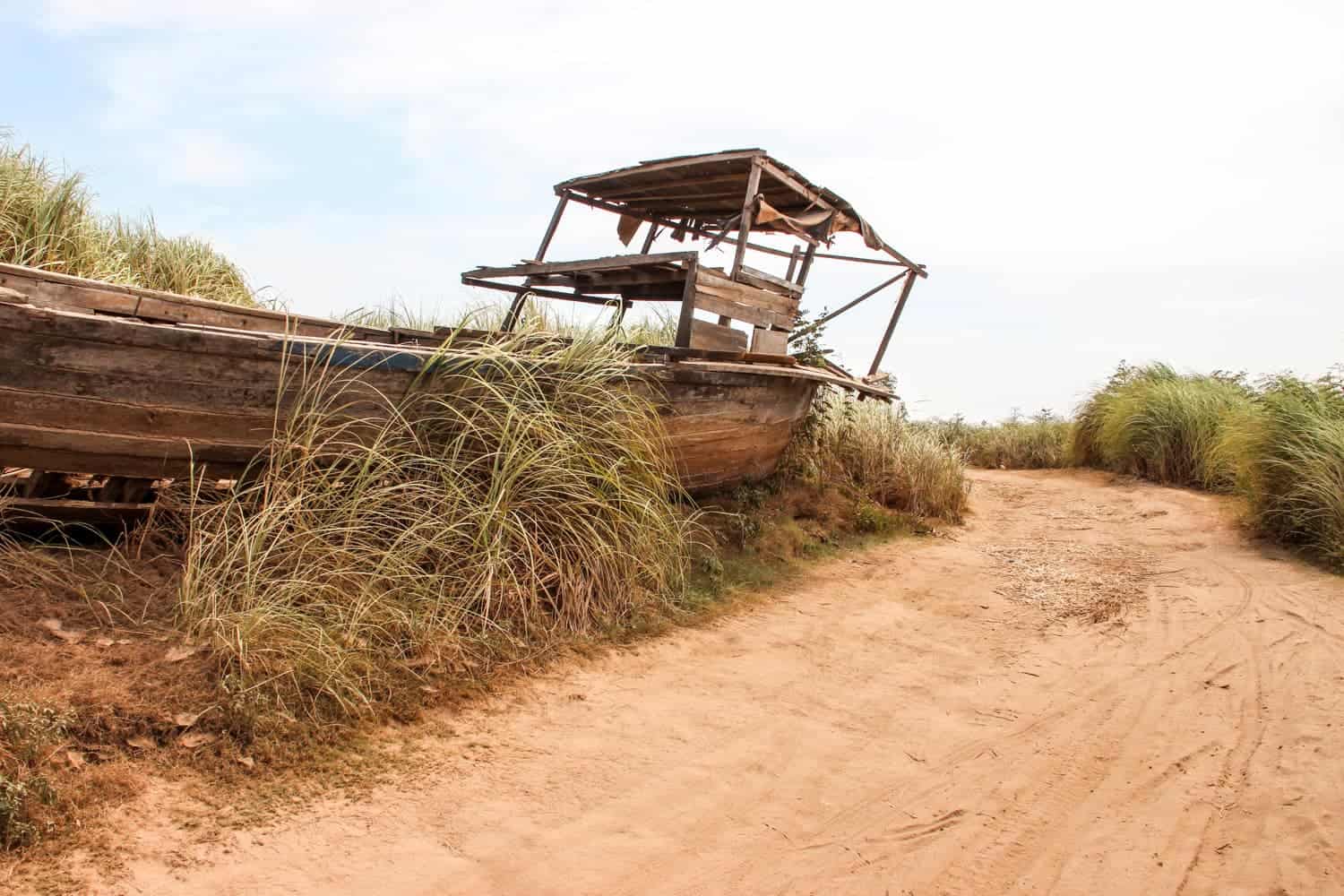
Seclusion away from the city.
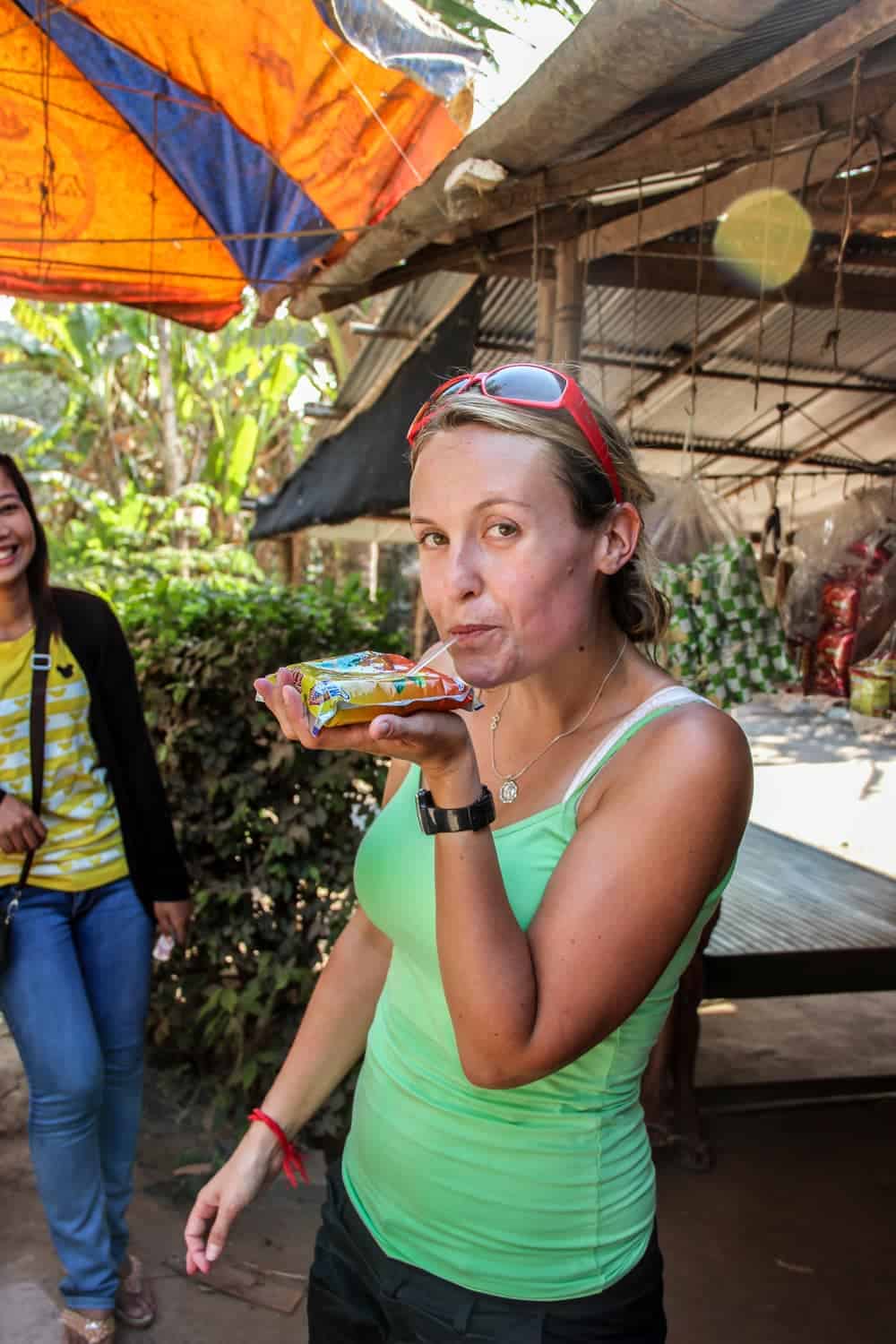
Village snack stop.
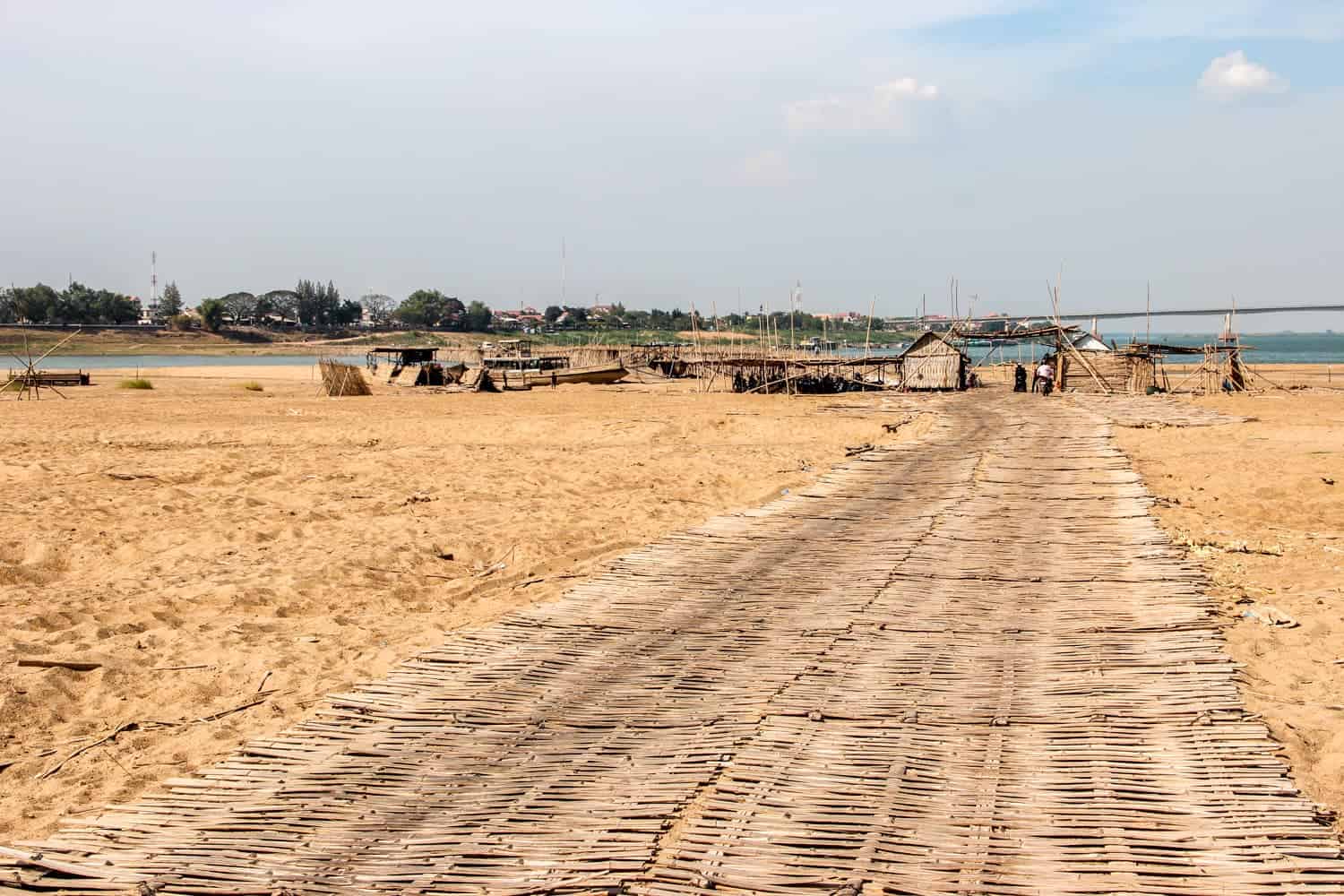
Bamboo bridge island.
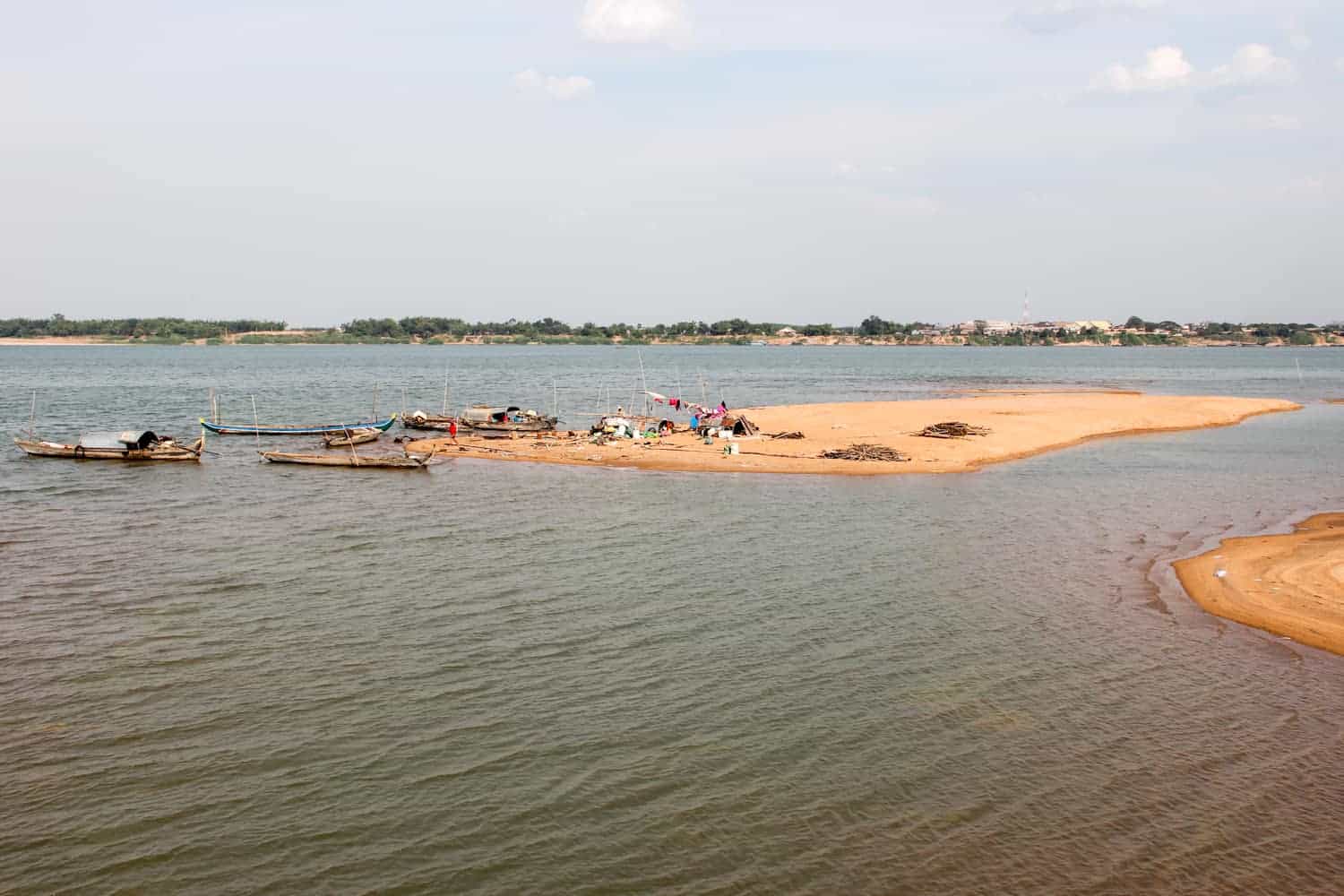
Life on the water in Kampong Cham.
Visit the Temple Complexes
Other sights in Kampong Cham are based out-of-town, including a pair of temples called Phnom Pros and Phnom Srey and the province’s last remaining wooden pagoda, Wat Maha Leap – one of the last remaining wooden pagodas left in the country.
We decided to visit what is affectionately known as Man and Woman Hill – where two hills each have a temple atop of them, surrounded by Kampong Cham’s ‘killing fields’, which is a beautiful area albeit slightly unnerving.
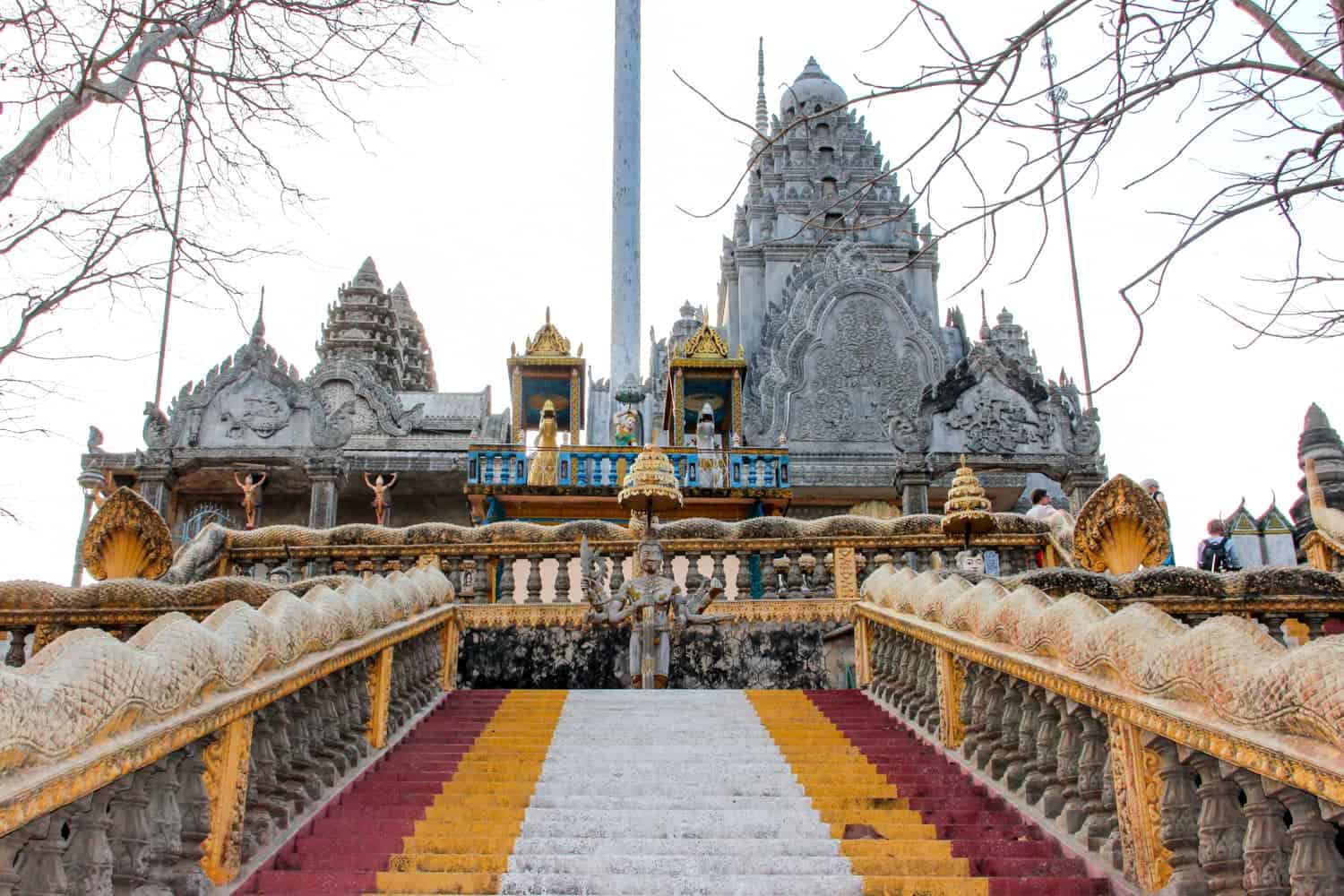
Phnom Pros and Phnom Srey temple in Kampong Cham.
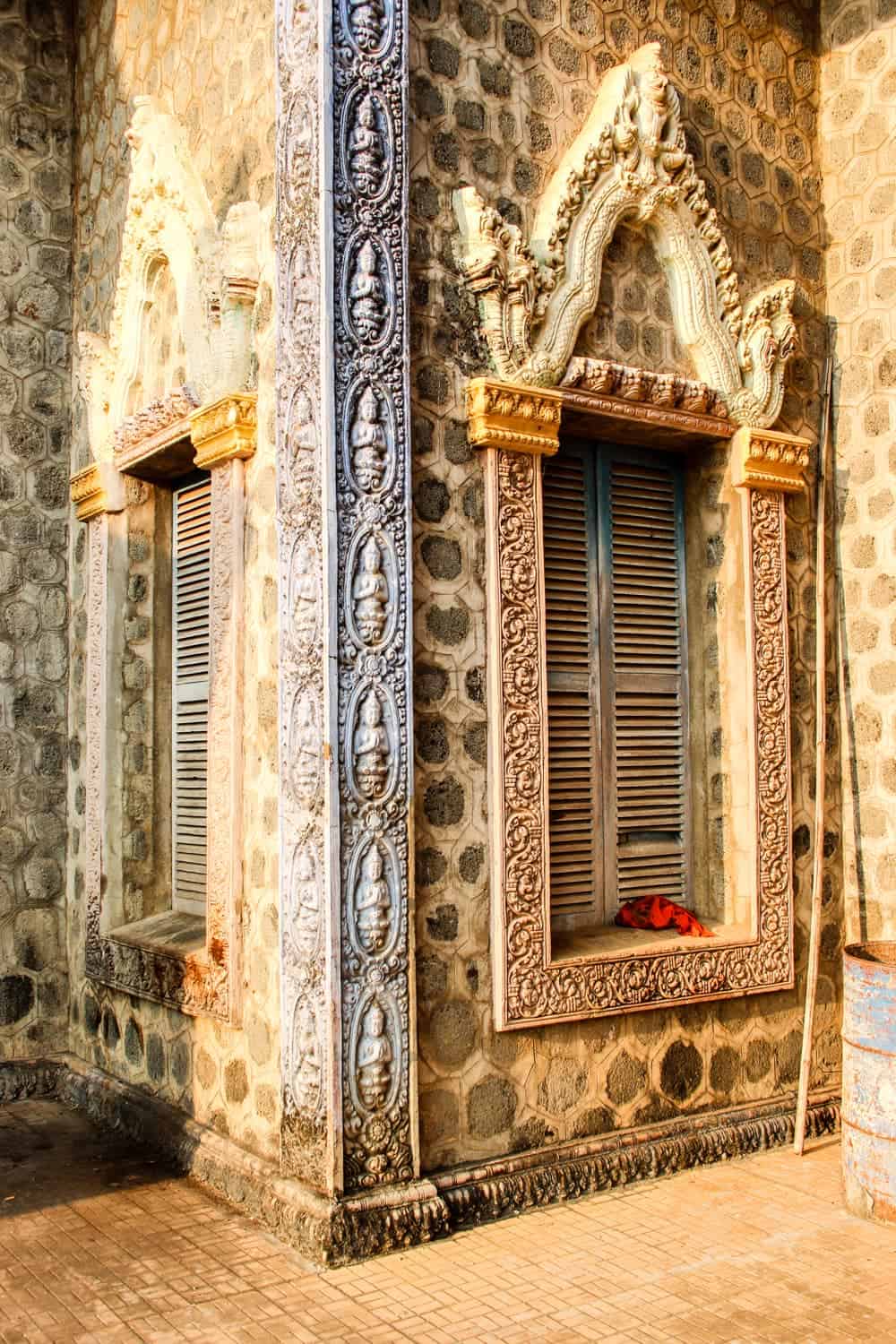
Inside Kampong Cham Phnom Pros and Phnom Srey.
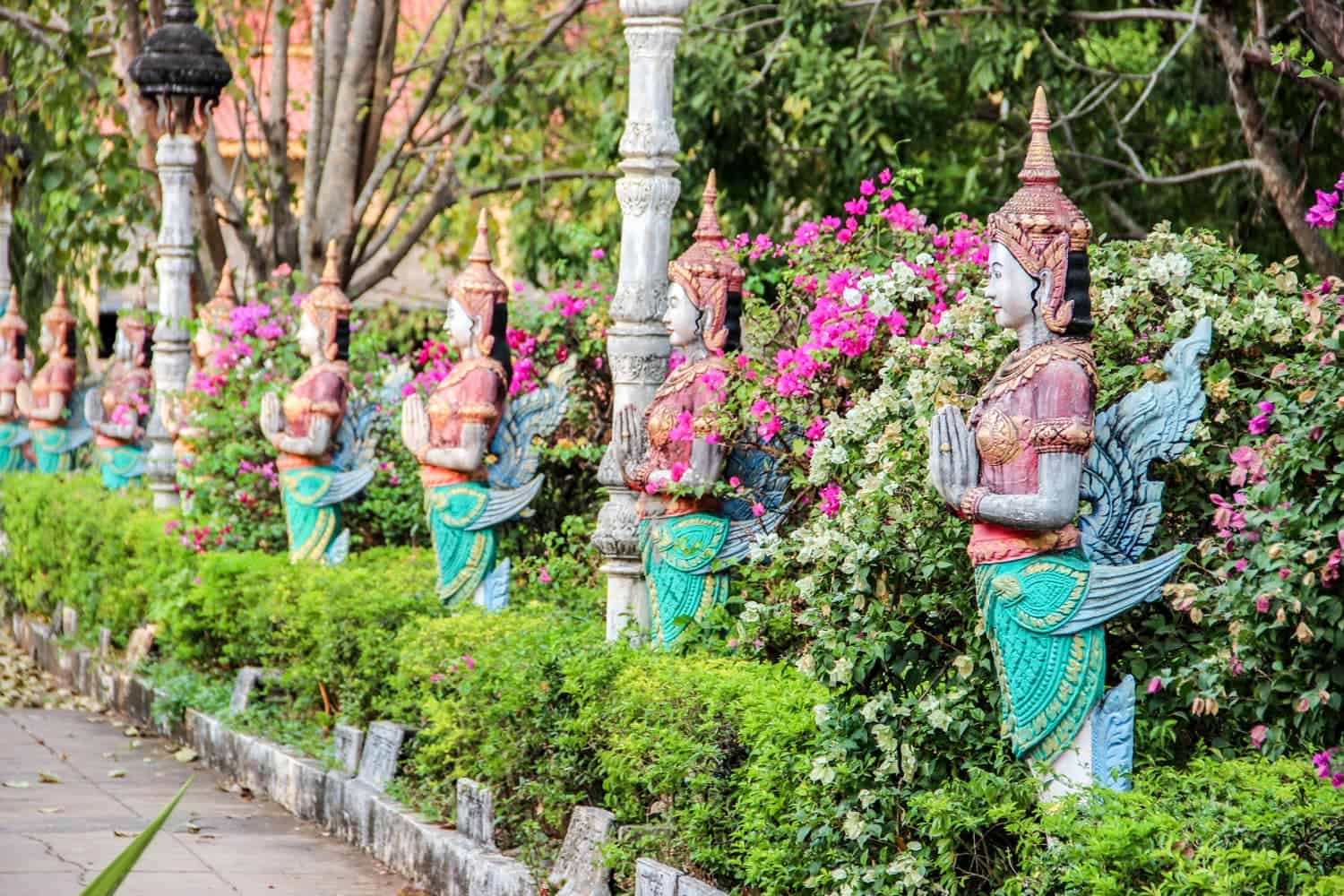
Phnom Srey temple in Kampong Cham, Woman Hill.
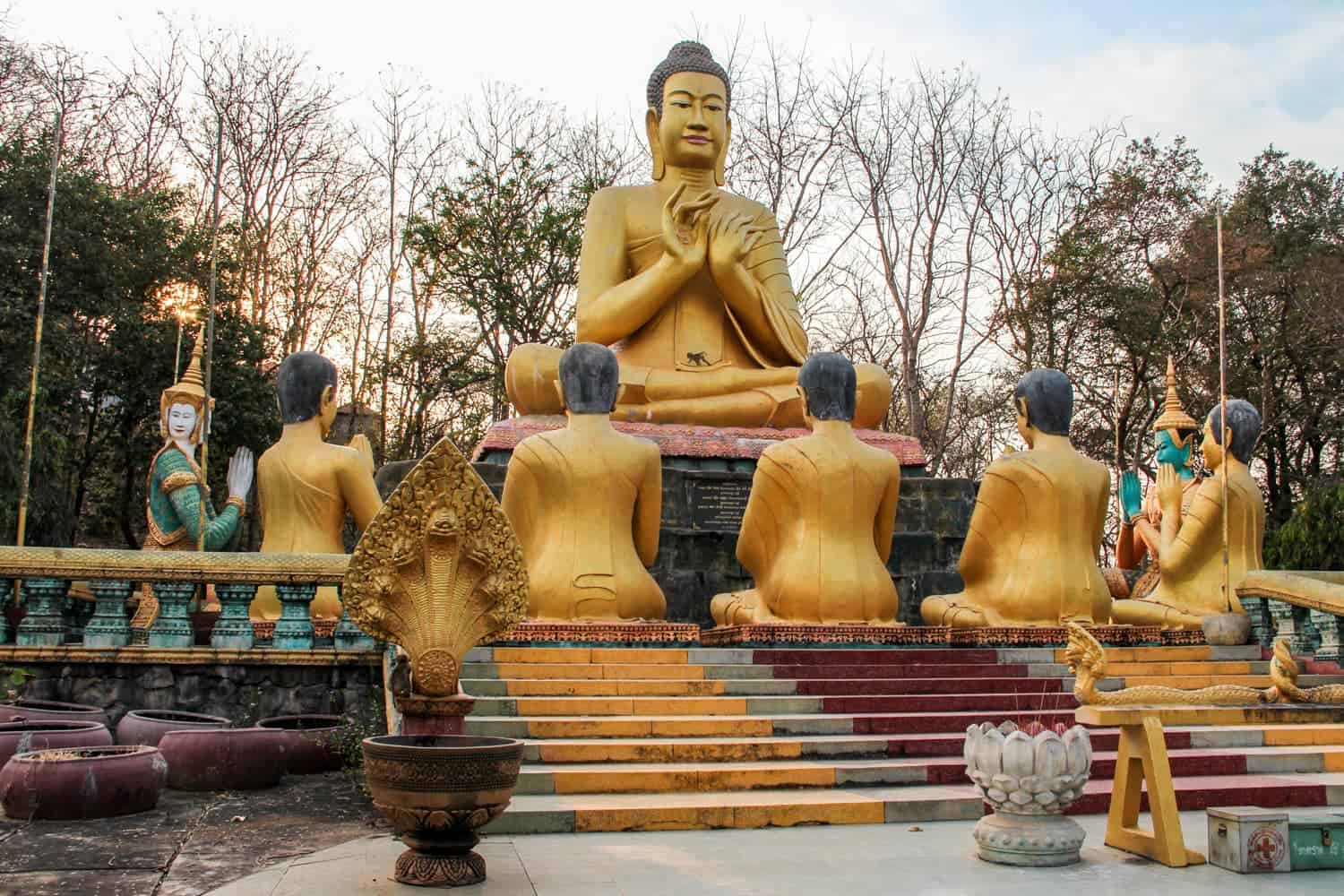
Phnom Pros in Kampong Cham, Man Hill.
If you have time, there is also a large temple complex, Wat Nokor (Banteay Prei Nokor), built with black sandstone and pre-dates Angkor Wat. It is located less than 30 minutes northwest of Kampong Cham, off the Phnom Penh highway, and easy to get to by taxi or bike.
A similar distance, 20km north of Kampong Cham, is the Mekong viewpoint hilltop pagoda, Wat Hanchey. The historic and now restored Old French Lighthouse also offers Mekong panoramas that make the climb up worth it.
Kampong Cham Waterfront and City Exploration
Daily life in Kampong Cham moves at its own pace and is a place to take a rest stop and not feel the need to have to rush around. You can meander the wide boulevards filled with crumbling colonial-era buildings or lose yourself in smaller city back streets.
The fact that nothing much happens here is a perfect reprieve from long travel and a chance to observe daily life and integrate more with local people.
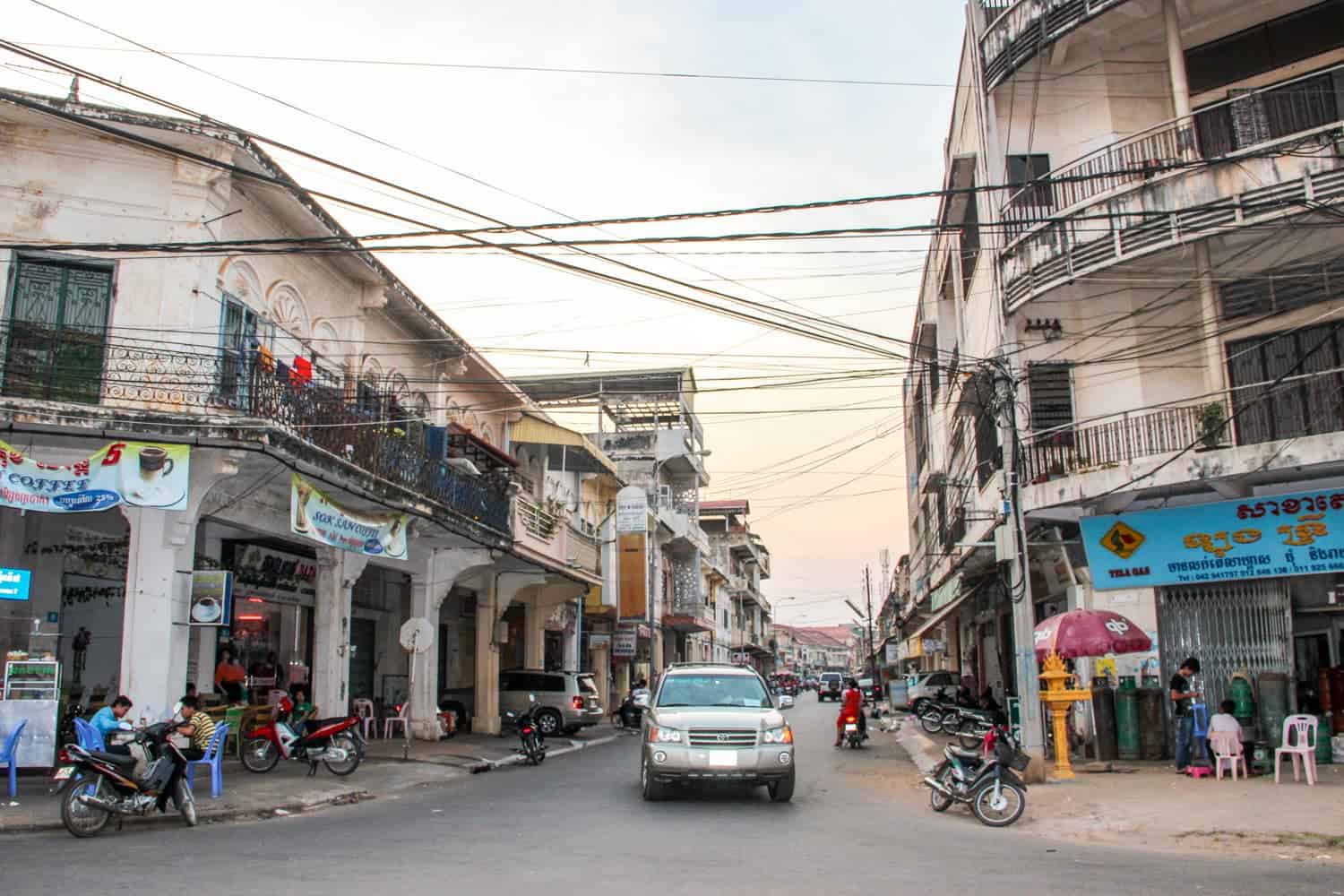
Daily life in the city.
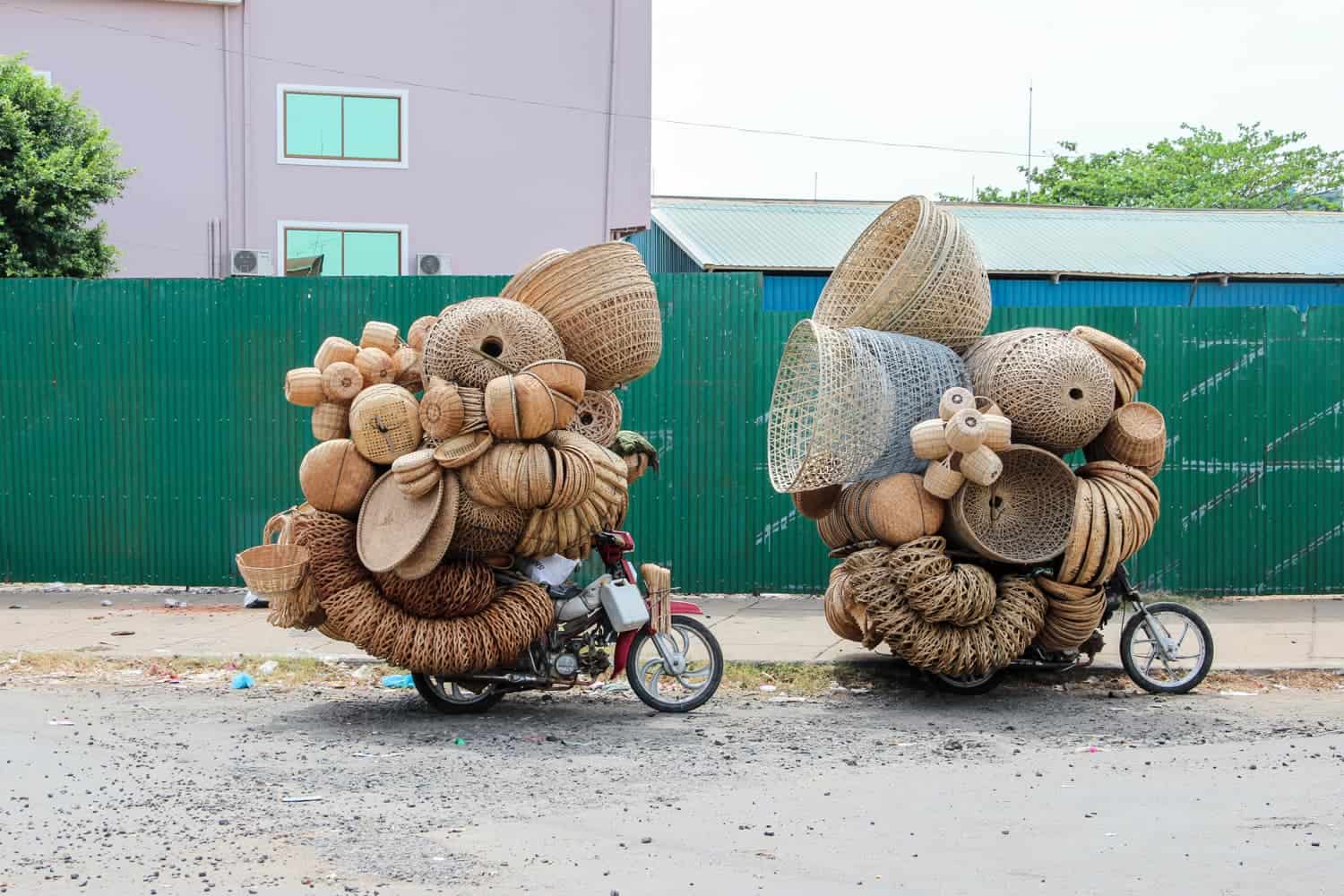
Mobile street vendors in the Cham.
Make sure to find time to walk along the waterfront promenade, which has become a popular spot for locals to take exercise classes during the day or hang out in the evenings.
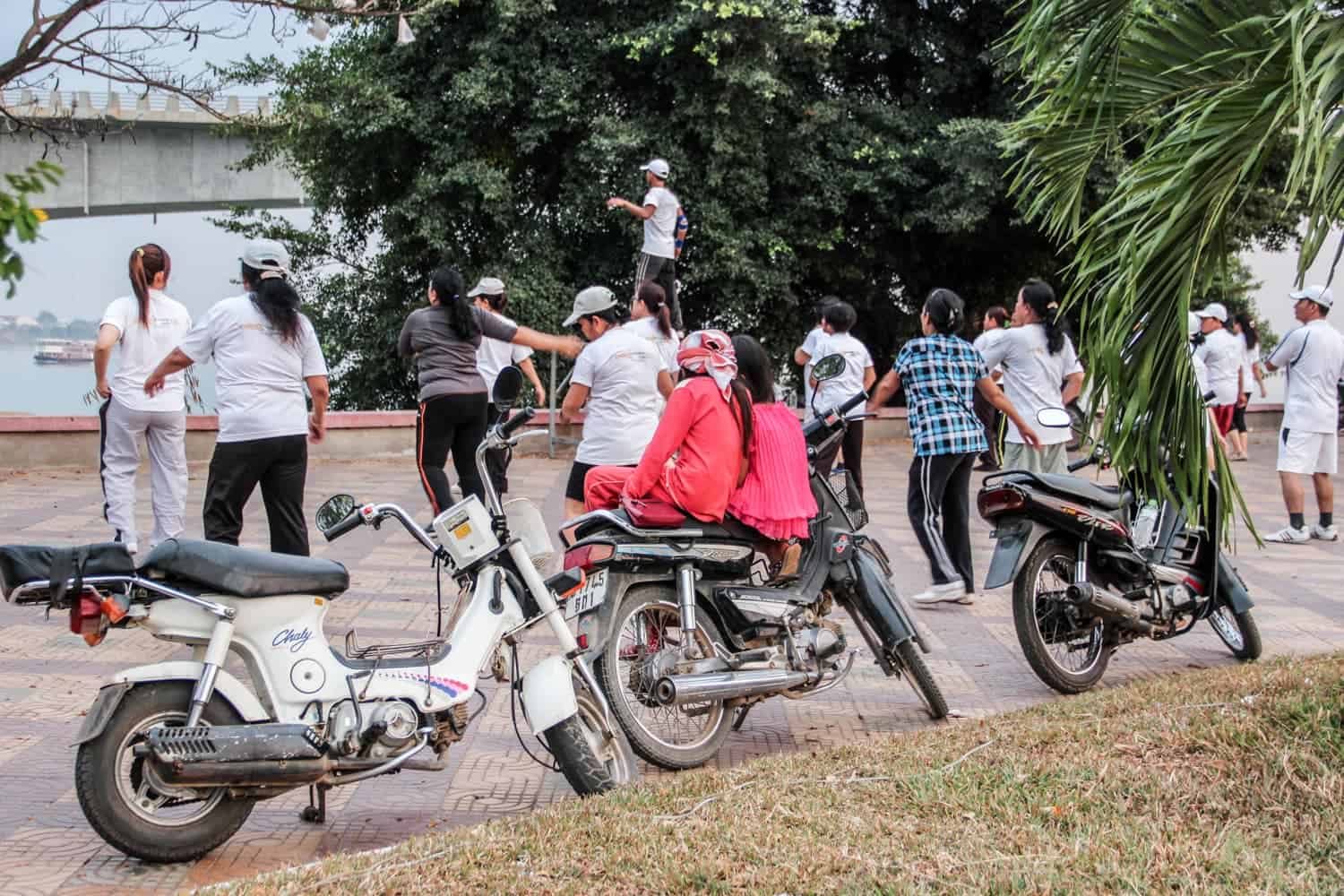
Kampong Cham waterfront promenade.
There’s no nightlife in Kampong Cham apart from soaking up the atmosphere at the local street food and clothing market, which has great food and decent fashion choices.
However, we got lucky – there was a beer-sponsored concert in town where we got to see a staged game of musical chairs and the extreme signing talent of a local blind boy who roused such generosity from the crowd (who eagerly clambered to the stage to donate money).
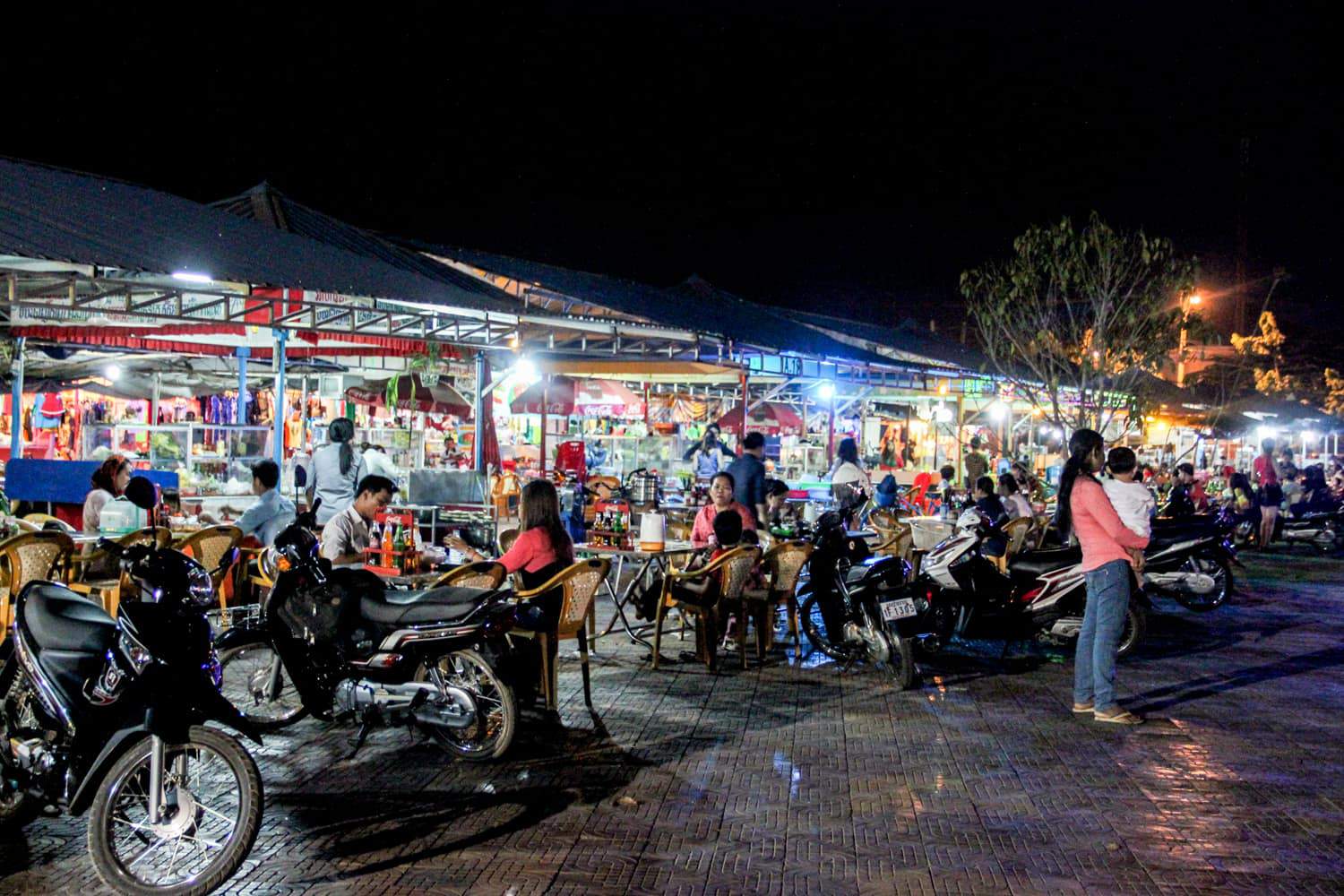
Kampong Cham’s nightlife – street food stalls, markets, and music.
We left with happy memories. Not only did we save ourselves backache and energy by not spending all day on buses getting to Mondulkiri, but we got to see a less-popular, untouched part of Cambodia.
Most importantly, travelling here resulted in having our preconceptions challenged, proving that’s it sometimes worth taking the risk and trying somewhere random. Spontaneity often produces the best of adventures and a real insight into local life, even if it initially appears bizarre.
How to Get to Kampong Cham City
The main highway NR6/NR7 connects the capital, Phnom Penh, to Kampong Cham. It’s well-paved, which means the long journeys are not too painful, and since it is a well-frequented road, there are no issues regarding safety.
Daily buses frequent this route; the total journey time is three hours.
- Daily buses depart from Phnom Penh Sorya Bus Terminal at 10:45, 11:45, 12:45, 15:45, 17:45, and 19.30 and arrive in Kampong Cham near May Bank.
- The Sorya bus ticket from Phnom Penh to Kampong Cham costs $7.25, or there is a minibus option for $9.
- You can book online with CamboTicket or directly at the bus station in Phnom Penh on the day.
- Taxi options The bus is a much cheaper alternative than a private taxi, which can cost up to $60 one way for a four-seater taxi SUV.
How Long to Spend in Kampong Cham, Cambodia
We spent two nights and three days in Kampong Cham, giving ourselves two days outside travel time. Kampong Cham was a stop-over as we made our way east to Mondulkiri and Ratanakiri.
While Kampong Cham is relaxed, low-key, and under the radar, there are still many things to do and experience. Exploring the Angkorian temples, landscapes, and everyday town life shouldn’t be rushed and doesn’t need to be – get into the pace of the town and immerse yourself slowly.
However, having only two full days in town is also sufficient time to get a decent introduction.
Where to Stay in Kampong Cham
Looking for a hotel in Kampong Cham? There are plenty of options now for those looking for a little comfort outside traditional Cambodian hotels to homestay-style accommodations in bamboo huts, perfect for relaxing in this beautiful rural setting.
Boutique: For a serene and environmentally conscious luxury stay at the Hanchey Bamboo Resort north of Kampong Cham town. The modern Reasmey Cheanich Hotel provides a stylish and comfortable base in a central location, just 300m from the (Thom Thmey) Central Market.
Homestay Style: Those looking for a homestay experience near the Mekong should check out OBT Homestay Chiro in Chiro Village. You can stay in a bamboo hut in rooms decked with comfortable matrasses, mosquito nets, and an overhead fan. You can relax on the terrace in a hammock and eat at the on-site restaurant that serves local dishes.
Traditional: The Mekong Hotel along Riverside Road is the largest in town and a typical Cambodian-style hotel. It lacks any particular flair or homely warmth, but you can often land good last-minute deals for multiple nights.
More on Cambodia Travel
For more Cambodia travel inspiration, you can view my full list of articles.
If you are looking for more lesser-known destinations in Cambodia, consider visiting Rabbit Island off the coastline of Kep, jungle trekking in Koh Kong and heading further out to the paradise island of Koh Rong Samloem.
If you are looking for more trodden-route towns, read my guide on the Things to Do in Kampot, Cambodia.
Cambodia Tours
If you want to travel in Cambodia with like-minded travellers in a small group, check out the G Adventures Ultimate Cambodian Adventure trip that makes a loop of the main city highlights and smaller towns from Phnom Penh, including an overnight visit to Kampong Cham! Time in Sihanoukville includes a transfer to your own private beach on Koh Rong Island for two nights.
As a G Adventures ambassador, I can vouch for their service, having taken many tours for over a decade. The fact that you will travel with a local Khmer guide is also invaluable for knowledge and guidance when travelling.

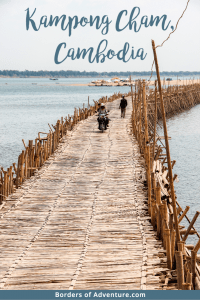

irene says
The wooden bridge would have made an historical structure, thou’ risky!
Avi says
Is the bamboo bridge gone ? Or are they reconstructing?
Becki says
No, it’s gone now as they have built a permanent structure.
Sab says
I live in Kampong Cham since four years.. a beautiful city but more… beautiful people.. the bamboo bridge go away with the Mekong when it’s the rainy season and they rebuilt it every year when the dry season starts.. so if you want to see that bridge you have to come between December and July..
Now we can only use the bridge by walk but it’s a nice walk above the Mekong and you can reach the beaches of Koh Penh island.. relaxing place in late afternoon and evening..
Danial says
This stop-over really has its Cham 😉
Pun aside, the bamboo bridge is really an architectural wonder and I find it mind-blowing to learn that the bridge has to be deconstructed and reconstructured every year!
Nikki says
Hi,
I am actually going to Cambodia in Nov. Reading this, I sm re-thinking my stay:) You had me at The Koh Pen Bamboo Bridge and then, it’s gone – boo! How lucky are you that you go to experience it though? And, thank you for sharing the pictures of what was. Nikki
Becki says
I am incredibly lucky to have experienced the Bamboo Bridge in Kampong Cham, as it’s a huge part of its history. But I still wouldn’t rule out visiting as it’s a great change of pace, a better window into other more rural parts of Cambodia and you can still visit the island on the other side of the (new) bridge.
Melissa says
Just a head’s up that the bamboo bridge has recently been replaced with a steel bridge. 🙁 My friend visited there last summer and made the discovery.
Becki says
I heard it might be disappearing at some point, so this is good to know. Thanks!
Yana says
Besides staying in a really sketchy hotel I had such a lovely time there. We decided to go there on the spur of the moment and our bus broke down on the way but it was totally worth it. I had some of the conversations with locals there and visited some of the most interesting places of my trip. Phnom Srey and Phnom Pros was a highlight and my tuk took driver took me to where he believes his family is resting; in the killing fields nearby. The strength of the khmer people that I met will always stay with me. We had drinks together that night and he brought along his friends. I’m so glad that my friend closed his eyes and picked this spot on the map.
Carolyn C says
Thankyou for your travel post. My friend has just moved to Kampong Cham for 12 months & it was great to read about your personal experiences there & see your photos.
Chandara Rin says
reading this post, brought me back the memories when i frequently lead trips there 4 years ago. The particular one when the storm was about to hit the island and i made the right call to stop everyone crossed the bridge, it was quite the moment. The consequent could have been very different but all we had after was the bigest smiles on everyone face, glad to be survived and the day remained to be one of my favourite day ever 🙂
Becki says
I remember seeing one group in my hotel and think they were on their way to Vietnam! A storm on the bridge would have been interesting!!
Chandara Rin says
yep, it is still on the list for Intrepid trips. G adventure also include it on the ultimate cambodia.
paul | walkflypinoy says
Agreed. It’s usually the places outside your itinerary that sticks with you more. Nice to see another side of Cambodia, one that’s not SR, PP or Sville
Becki says
There’s so much more to Cambodia… although if people looked beyond the attractions in PP and SR they would find hidden gems there too 🙂
Rob S says
What a great post! It’s so nice to see there are still backpackers who like to put down their guidebooks and explore the lesser known nooks and crannies of different countries. As your story and pictures show, it can be very rewarding and enriching.
Max says
Definitely one of Cambodia’s best hidden wonders. I actually almost fell off the bridge last time I crossed it… One of my favorite thing to do in the city is to just sit by the waterfront and do people-watching while sipping on my iced sweet soy milk.
Anther fact about the city: it is the home of the largest muslim community in Cambodia. Cham is actually the name of the muslim minority group in Cambodia.
Becki says
I nearly fell off too… it’s a good challenge trying to get over and trying to wrestle with the wind on the way back!!! I saw some awesome aerobics session on the riverfront – I agree, a great people watching spot!